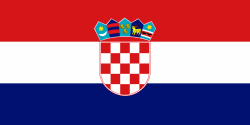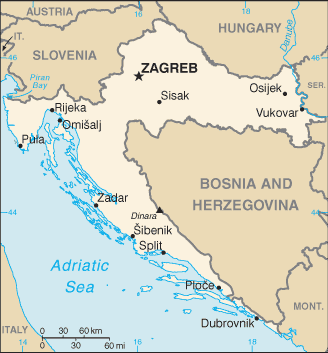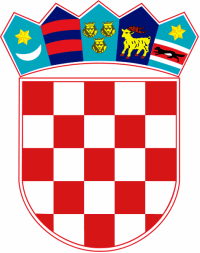Republic of Croatia
Related Categories:
 Flag of Croatia
Flag of CroatiaThree equal horizontal bands of red (top), white, and blue superimposed by the Croatian coat of arms (red and white checkered). |

 Croatia Coat of Arms
Croatia Coat of Arms |
National Flag, Civil Ensign, Naval Ensign, Naval Jack.
zeljko-heimer-fame.from.hr/
An Overview of the Croatian Flags, Use of the Flag, Vertical Hoisting of the Flag, Use of the Flag with the Red Star, Use of Short Flag and Rotated Coat of Arms, Croatia Changes Its Flag?
www.fotw.us/flags/hr.html Croatia - wikipedia.org
Croatia is located in Southern Europe. Its shape resembles that of a crescent or a horseshoe, which flanks its neighbours Serbia, Bosnia and Herzegovina and Montenegro.
en.wikipedia.org/
The Croats are believed to be a purely Slavic people who migrated from Ukraine and settled in present-day Croatia during the 6th century. After a period of self-rule, Croatians agreed to the Pacta Conventa in 1091, submitting themselves to Hungarian authority. By the mid-1400s, concerns over Ottoman expansion led the Croatian Assembly to invite the Habsburgs, under Archduke Ferdinand, to assume control over Croatia. Habsburg rule proved successful in thwarting the Ottomans, and by the 18th century, much of Croatia was free of Turkish control.
In 1868, Croatia gained domestic autonomy while remaining under Hungarian authority. Following World War I and the demise of the Austro-Hungarian Empire, Croatia joined the Kingdom of Serbs, Croats, and Slovenes (the Kingdom of Serbs, Croats, and Slovenes became Yugoslavia in 1929). Yugoslavia changed its name once again after World War II. The new state became the Federal Socialist Republic of Yugoslavia and united Croatia and several other states together under the communistic leadership of Marshall Tito (born Josip Broz).
After the death of Tito and with the fall of communism throughout eastern Europe, the Yugoslav federation began to crumple. Croatia held its first multi-party elections since World War II in 1990. Long-time Croatian nationalist Franjo Tudjman was elected President, and one year later, Croatians declared independence from Yugoslavia. Conflict between Serbs and Croats in Croatia escalated, and one month after Croatia declared independence, civil war erupted.
The United Nations mediated a cease-fire in January 1992, but hostilities resumed the next year when Croatia fought to regain one-third of the territory lost the previous year. A second cease-fire was enacted in May 1993, followed by a joint declaration the next January between Croatia and Yugoslavia. However, in September 1993, the Croatian Army led an offensive against the Serb-held Republic of Krajina. A third cease-fire was called in March 1994, but it, too, was broken in May and August 1995 after Croatian forces regained large portions of Krajina, prompting an exodus of Serbs from this area. In November 1995, Croatia agreed to peacefully reintegrate Eastern Slavonia, Baranja, and Western Dirmium under terms of the Erdut Agreement. In December 1995, Croatia signed the Dayton peace agreement, committing itself to a permanent cease-fire and the return of all refugees.
The death of President Tudjman in December 1999, followed by the election of a coalition government and President in early 2000, brought significant changes to Croatia. The government, under the leadership of then-Prime Minister Racan, progressed in implementation of the Dayton Peace Accords, regional cooperation, refugee returns, national reconciliation, and democratization.
On November 23, 2003, national elections were held for Parliament. The current government, headed by Prime Minister Ivo Sanader, took office in December 2003. The Sanader government has made membership for Croatia in the European Union and in NATO its top priorities. Elections for Parliament are not expected again until November 2007. Presidential elections were held in January 2005. President Mesic was re-elected to a second term in office, defeating Croatian Democratic Union (HDZ) candidate Jadranka Kosor in two rounds of balloting. President Mesic was inaugurated for a second term on February 18, 2005. Presidential elections will next be held in January 2010.
www.state.gov/r/
Introduction
About
Contact
Symbols in The News
Interpret this Symbol
AAC
African
AI
Alchemy
Alphabets
Ancient
Animal Symbolism
Architecture
Art
Articles
Astrology
Baha'i
Blissymbolics
Blueprint Symbols
Buddhist
Celtic Symbols
Cemetery
Chinese Symbols
Christian
Circle
City
Codes
Color
Conlangs
Crop Circles
Danger
Da Vinci Code
Designing Logos
Dictionaries
Dreams
Education
Egyptian Symbols
Electrical
Emoticons
Find Images
Fonts
Food
Fraternity
Hamsa
Healing
Heraldry
Hermetic
Highway Signs
Hindu
History
Hobo
Holiday
Icons
iConji
Islamic
Jain Symbols
Japanese, Kanji
Jewish
Justice
Law
Literary Symbolism
Mandalas
Map
Masonic
Math, Number
Meaning of Names
Medical
Middle East
Military
Miscellaneous
Money
Music
Mythology
Native American
Playing Cards
Power
Psychology
QiQiiKhu
Reiki
Religious
Runes, Norse
Sacred Geometry
Scientific
Science Fiction
Sorority
Sports
Symbols in the News
Tattoos
ThirteenSymbols
Tree of Life
Ursprache
Videos
Visual Languages
Weather
Web Codes
Wicca
Words
Writing Systems
Braille
Coinherence
Coptic
Cuneiform
Easter Island
Etruscan
Happy Human
Hebrew
Kokopelli
Linear B
Lotus
Love Symbols
Mandorla
Moon Alphabet
Nine Pointed Star
Om
Oz
Phonetic
Scarab Beetle
Silent
Theosophy
Unifon
About
Contact
Symbols in The News
Interpret this Symbol
AAC
African
AI
Alchemy
Alphabets
Ancient
Animal Symbolism
Architecture
Art
Articles
Astrology
Baha'i
Blissymbolics
Blueprint Symbols
Buddhist
Celtic Symbols
Cemetery
Chinese Symbols
Christian
Circle
City
Codes
Color
Conlangs
Crop Circles
Danger
Da Vinci Code
Designing Logos
Dictionaries
Dreams
Education
Egyptian Symbols
Electrical
Emoticons
Find Images
Fonts
Food
Fraternity
Hamsa
Healing
Heraldry
Hermetic
Highway Signs
Hindu
History
Hobo
Holiday
Icons
iConji
Islamic
Jain Symbols
Japanese, Kanji
Jewish
Justice
Law
Literary Symbolism
Mandalas
Map
Masonic
Math, Number
Meaning of Names
Medical
Middle East
Military
Miscellaneous
Money
Music
Mythology
Native American
Playing Cards
Power
Psychology
QiQiiKhu
Reiki
Religious
Runes, Norse
Sacred Geometry
Scientific
Science Fiction
Sorority
Sports
Symbols in the News
Tattoos
ThirteenSymbols
Tree of Life
Ursprache
Videos
Visual Languages
Weather
Web Codes
Wicca
Words
Writing Systems
Braille
Coinherence
Coptic
Cuneiform
Easter Island
Etruscan
Happy Human
Hebrew
Kokopelli
Linear B
Lotus
Love Symbols
Mandorla
Moon Alphabet
Nine Pointed Star
Om
Oz
Phonetic
Scarab Beetle
Silent
Theosophy
Unifon
